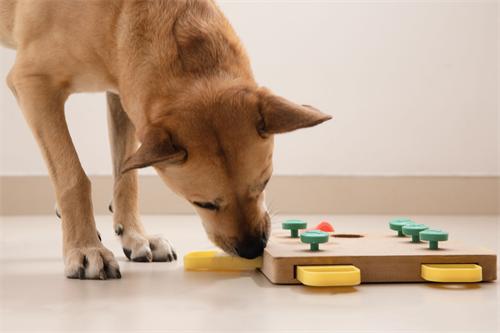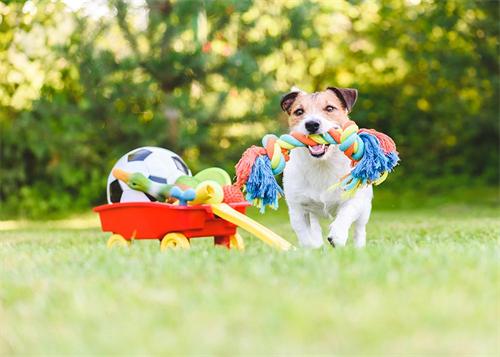Interactive Dog Toys for Mental Health: New Products for 2025

In 2025, dogs are no longer just companions—they are family members, emotional support systems, and even health partners. As our understanding of canine psychology deepens, one of the most important discoveries in modern pet care is the role mental stimulation plays in a dog's overall well-being. Along with daily walks and good nutrition, interactive dog toys have become one of the most effective ways to boost mental health, reduce stress, and enrich a dog's daily life.
This year, the pet industry entered a new era of innovation, combining behavioral science with technology and sustainable design to create toys that not only entertain, but also heal and educate. From sensory puzzles to AI-powered playmates, interactive dog toys are redefining how we support our furry friends' mental health.
The Rise of Dog Mental Health Care
For decades, physical exercise has been considered a cornerstone of dog health. Many owners believe that a tired dog is a happy one. However, veterinary behaviorists and animal psychologists have proven that mental fatigue can be just as exhausting as physical activity, but equally beneficial.
When dogs don't get enough mental stimulation, they often exhibit destructive or anxious behaviors: chewing furniture, barking, digging, or being restless. These aren't signs of disobedience, but rather calls for engagement.
Canine mental health encompasses several key elements: problem-solving, emotional regulation, curiosity, and environmental enrichment. Interactive play helps dogs achieve this balance by engaging their minds, challenging them, and stimulating their natural instincts, such as hunting, sniffing, and strategizing.
In 2025, this understanding inspired a new generation of dog toys designed not only for entertainment but also for cognitive development and emotional well-being.
How Interactive Toys Promote Mental Health?
Interactive toys differ from typical chew toys or fetch balls because they require dogs to think. They often incorporate tasks, surprises, and rewards, stimulating multiple areas of the brain. The benefits extend beyond fun—they can also positively impact a dog's emotional and mental health.
1. Reduce Anxiety and Boredom
Dogs, especially highly social breeds, can become anxious or depressed when left alone. Interactive toys help capture their attention and provide comfort during these times, making them feel less lonely and more secure.
2. Build Confidence
As dogs master puzzles or interactive challenges, their confidence grows. Each completed task releases dopamine—the feel-good chemical—creating a positive feedback loop that boosts confidence and curiosity.
3. Improve Problem-Solving Skills
Like humans, dogs benefit from mental exercise. Learning how to manipulate toys to earn rewards can cultivate perseverance, patience, and focus.
4. Strengthen the Human-Dog Bond
Interactive play can enhance communication between pets and owners. Many modern toys allow owners to participate, transforming playtime into shared learning and collaboration.

The Evolution of Interactive Dog Toys in 2025
Interactive dog toys in 2025 will be more sophisticated than ever, integrating behavioral science, smart technology, and sustainable craftsmanship. Here are the most exciting trends shaping the lives of canines this year.
1. Cognitive Challenge Toys
Puzzle toys are becoming increasingly complex and adaptable. Unlike traditional static challenge designs, new toys can now automatically adjust their difficulty based on a dog's performance. For example, if a dog solves a task too quickly, the toy might add an extra step to ensure prolonged engagement. These cognitive challenges mimic the problem-solving tasks dogs encounter in nature—such as tracking a scent or finding hidden prey—keeping their minds active and sharp.
2. Scent-Based Enrichment Systems
Smell is a dog's most powerful sense, and olfactory toys are poised for explosive growth in 2025. These toys are designed to stimulate a dog's natural foraging instinct. They use hidden scent compartments, replaceable aromatherapy capsules, or treats wrapped in fabric layers to encourage dogs to "hunt" with their noses. This not only reduces stress but also stimulates the same satisfaction dogs get when foraging in the wild—a relaxing, instinctive rush.
3. Smart Toys with Emotional AI
Artificial intelligence has entered the pet world in fascinating ways. Some of the latest interactive toys use artificial intelligence to learn a dog's play style and adjust their responses in real time. These smart toys can recognize a dog's movement patterns, energy level, and even mood—providing playful encouragement when the dog is active and gentle interaction when anxious. For example, if a toy senses a dog has been inactive for a long time, it might gently roll toward the dog, flash colors, or emit friendly sounds to attract the dog's attention. The goal of these toys is not just stimulation but also companionship.
4. Voice-Responsive and Motion-Sensitive Games
By 2025, many toys will respond to a dog's barking, paw movements, or specific sound cues. Using motion sensors, they can sense if a dog is nearby and react dynamically—bouncing, rolling, or making sounds. These reactions simulate real-life interactions with other animals, providing both entertainment and cognitive development.
5. Eco-Friendly Design and Biodegradable Materials
Pet owners are becoming increasingly environmentally conscious, and toy manufacturers are responding. The latest generation of interactive toys are made from recyclable, non-toxic materials, making them safe for dogs and kind to the planet. Some toys even feature biodegradable components or solar charging systems for electronic toys—a fusion of sustainability and innovation.
6. Modular and Customizable Systems
Like humans, dogs can get bored with daily chores. Modular toy systems allow owners to swap out components to keep things interesting. A single toy can become a variety of challenges—from puzzles to tug-and-pull mechanisms to scent play. This adaptability extends the toy's lifespan and helps dogs through different life stages, from curious puppies to slow-moving seniors.
7. Mindful Play for Senior Dogs
Senior dogs also need mental exercise, but their play should focus on gentle interaction rather than intense stimulation. New interactive toys are being designed with soft materials, slower movements, and memory-based activities to meet the needs of older dogs. These toys help maintain cognitive health and emotional balance, just like brain training for humans.

The Science Behind Mental Stimulation
Behind the fun and flashing lights, interactive dog toys are rooted in neuroscience and animal behavior. When dogs play with stimulating toys, several key brain areas are activated—including those associated with problem-solving, reward, and emotion regulation.
Dopamine release: Solving a puzzle triggers a reward response, making dogs happier and more motivated to learn.
Cognitive flexibility: Complex tasks can enhance adaptability and focus.
Reduced stress hormones: Engaging in activities can lower cortisol levels, reducing anxiety and tension.
Improved neural connections: Frequent intellectual challenges strengthen synapses, improving long-term memory and learning.
Essentially, interactive toys act as "brain exercise," promoting neural health in a similar way to how humans benefit from puzzles and games.
Choosing the Right Interactive Toy
Not all toys are created equal, and the best choice depends on your dog's personality, size, and energy level. Here are some guidelines for choosing the right toy:
Match the challenge to your dog—Start with a simple design suitable for beginners and gradually increase complexity to build confidence.
Prioritize safety—Choose toys made of non-toxic materials and avoid small parts that could be swallowed.
Consider energy levels—high-energy breeds may prefer motion-based toys, while calmer dogs may enjoy scents or educational activities.
Encourage variety—rotate toys weekly to keep experiences fresh and prevent boredom.
Observe and adapt—watch your dog's interaction with each toy. The best toys are those that capture their attention without frustrating them.
Dogs are emotionally engaged creatures. Their brains release oxytocin—the same bonding hormone in humans—during affectionate interactions or playful play. Interactive play strengthens this bond, creating a feedback loop of joy and trust between pet and owner.
In 2025, toy designers will focus not only on cognitive engagement but also on emotional intelligence. Toys will incorporate softer materials, soothing textures, and gentle sounds to create a sense of comfort and security. This emotionally enriching approach is designed to help dogs cope with anxiety, separation stress, or trauma, providing stimulation and comfort.
In 2025, interactive dog toys will be more than just a trendy gadget; they'll be essential tools for promoting mental health and emotional well-being. Through play, dogs learn patience, focus, and resilience. They can boost their confidence, actively expend energy, and build deeper bonds with their human companions.
As technology and behavioral science continue to merge, the world of canine enrichment will only become more complex. However, one simple fact remains constant: dogs need to play—not just to pass the time, but to feel alive, understood, and fulfilled.
Interactive dog toys are no longer a luxury—they are a bridge between species, connecting emotions, intelligence, and love through the universal language of play.



